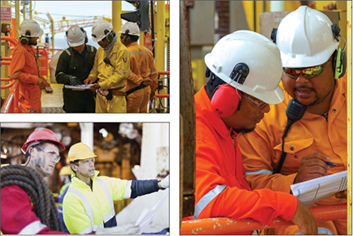No other form of communication has a larger effect on safety than face-to-face supervisor-employee conversations.

When supervisors doubled the number of conversations that included safety, unsafe acts fell by 20%.
When supervisors talk about safety, employees listen.

In a safety behavior study, researchers looked at two things: how frequently supervisors talked about safety and the number of safety incidents.
They found that in facilities where supervisors talked more frequently about safety, unsafe acts were less likely to occur. These include:
- unsafe material handling incidents
- lockout/tagout errors
- personal protective equipment (PPE) violations.
Supervisors talking about safety has a bigger impact than:
- safety posters
- emails
- training
- websites.
Source: Zohar, D. and G. Luria, “The Use of Supervisory Practices as Leverage to Improve Safety Behavior: A Cross-Level Intervention Model,” Journal of Safety Research, 34 (5), pp. 567–577, www.sciencedirect.com/science/article/pii/S0022437503000781 (Mar. 2003).
This Safety Minute was prepared by Larkin Communication (www.larkin.biz) in partnership with CEP.
Background and References
When it comes to safety, supervisor communication drives the biggest improvements.
Supervisor communication dominates safety in Dutch chemical plants.

A researcher found a strong correlation (r = –0.65) between supervisors’ informal conversations about safety and serious accidents in eight Dutch chemical plants. Typically, any correlation larger than ±0.2 is considered statisically significant.
Detailed written instructions about the work permit had no effect on safety, while a more informal conversation had a large effect, greatly reducing incidents.
Source: As, S. V., “Communication and Industrial Accidents,” SOM Research Report, Univ. of Groningen, The Netherlands, www.rug.nl/research/portal/files/3111189/01A24.pdf (2001).
When supervisors ask for safety improvements, they get them.

Compliance with written safety standards (involving handling hazardous materials) climbed from 47% to 74% when supervisors personally asked for compliance.
A posted sign showing the correct procedure and supplemental written procedures had no effect. However, when a supervisor entered the lab and had a face-to-face conversation in which they specifically asked employees to wear PPE, compliance significantly improved.
Supervisors have a greater impact on safety than company culture.
Source: Wogalter, M. S., et al., “Research-Based Guidelines for Warning Design and Evaluation,” Applied Ergonomics, 33, pp. 219–230, www.who.int/fctc/guidelines/ArtElevenWogalterNine.pdf (2002).
Supervisors have a greater impact on safety than company culture.

A study compared five oil companies that operated multiple offshore platforms in the Norwegian continental shelf region.
The variance in safety incidents between the companies was small. In other words, the companies had similar overall safety performance.
However, variance between platforms within each company was large — each company had some good and some poor-performing platforms.
Researchers concluded that the overall company culture has a relatively small influence on safety, but the local platform management has a large influence on safety performance.
Source: Høivik, D., “What Is Most Important for Safety Climate: The Company Belonging or the Working Environment? A Study from the Norwegian Continental Shelf,” Safety Science, 47 (10), pp. 1324–1333, www.sciencedirect.com/science/article/pii/S0925753509000757 (Dec. 2009).
This Safety Minute was prepared by Larkin Communication (www.larkin.biz) in partnership with CEP.

Copyright Permissions
Would you like to reuse content from CEP Magazine? It’s easy to request permission to reuse content. Simply click here to connect instantly to licensing services, where you can choose from a list of options regarding how you would like to reuse the desired content and complete the transaction.
